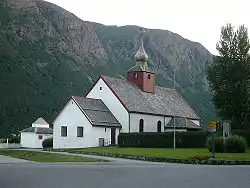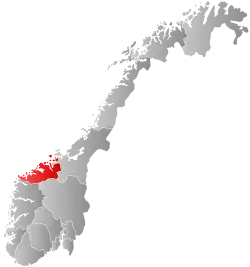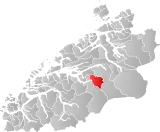Hen Municipality
Hen herred | |
|---|---|
 | |
 Møre og Romsdal within Norway | |
 Hen within Møre og Romsdal | |
| Coordinates: 62°33′N 07°49′E / 62.550°N 7.817°E | |
| Country | Norway |
| County | Møre og Romsdal |
| District | Romsdal |
| Established | 1 Jan 1902 |
| • Preceded by | Grytten Municipality |
| Disestablished | 1 Jan 1964 |
| • Succeeded by | Rauma Municipality |
| Administrative centre | Isfjorden |
| Area (upon dissolution) | |
| • Total | 245 km2 (95 sq mi) |
| Population (1964) | |
| • Total | 1,663 |
| • Density | 6.8/km2 (18/sq mi) |
| Time zone | UTC+01:00 (CET) |
| • Summer (DST) | UTC+02:00 (CEST) |
| ISO 3166 code | NO-1540[1] |
Hen is a former municipality in Møre og Romsdal county, Norway. The 245-square-kilometre (95 sq mi) municipality existed from 1902 until its dissolution in 1964. Hen encompassed the valleys extending to the south and east of the Isfjorden in the northeastern part of the present-day Rauma Municipality. The administrative center of Hen was the village of Isfjorden. The area of Hen Municipality is still a parish within the municipality of Rauma. The parish has one church, Hen Church, located in Isfjorden.[2][3]
The mountains Kyrkjetaket and Gjuratinden are both located in Hen.
History
The municipality of Hen was established on 1 January 1902 when the large Grytten Municipality was divided into Hen (population: 1,128) and Grytten (population: 1,728). During the 1960s, there were many municipal mergers across Norway due to the work of the Schei Committee. On 1 January 1964, the municipality of Hen (population: 1,663) was merged with the neighboring municipalities of Eid (population: 381), Grytten (population: 3,683), Voll (population: 1,163), and the southern part of Veøy municipality (population: 1,400) to form the new Rauma Municipality.[2][4]
Name
The municipality (originally the parish) is named after the old Hen farm (Old Norse: Hávin) since the first Hen Church was built there. The meaning of the first element is uncertain. It could be hár which means "high" or alternatively há which means "the grass that grows after the first crop has been mown". The last element is vin which means "meadow" or "pasture".[5]
Government
While it existed, this municipality was responsible for primary education (through 10th grade), outpatient health services, senior citizen services, unemployment, social services, zoning, economic development, and municipal roads. During its existence, this municipality was governed by a municipal council of directly elected representatives. The mayor was indirectly elected by a vote of the municipal council.[6]
Municipal council
The municipal council (Herredsstyre) of Hen was made up of 13 representatives that were elected to four year terms. The party breakdown of the final municipal council was as follows:
| Party name (in Norwegian) | Number of representatives | |
|---|---|---|
| Labour Party (Arbeiderpartiet) | 3 | |
| Conservative Party (Høyre) | 1 | |
| Joint List(s) of Non-Socialist Parties (Borgerlige Felleslister) | 7 | |
| Local List(s) (Lokale lister) | 2 | |
| Total number of members: | 13 | |
| Party name (in Norwegian) | Number of representatives | |
|---|---|---|
| Labour Party (Arbeiderpartiet) | 4 | |
| Joint List(s) of Non-Socialist Parties (Borgerlige Felleslister) | 9 | |
| Total number of members: | 13 | |
| Party name (in Norwegian) | Number of representatives | |
|---|---|---|
| Labour Party (Arbeiderpartiet) | 3 | |
| Joint List(s) of Non-Socialist Parties (Borgerlige Felleslister) | 9 | |
| Total number of members: | 12 | |
| Party name (in Norwegian) | Number of representatives | |
|---|---|---|
| Labour Party (Arbeiderpartiet) | 3 | |
| Joint List(s) of Non-Socialist Parties (Borgerlige Felleslister) | 9 | |
| Total number of members: | 12 | |
| Party name (in Norwegian) | Number of representatives | |
|---|---|---|
| Labour Party (Arbeiderpartiet) | 3 | |
| Local List(s) (Lokale lister) | 9 | |
| Total number of members: | 12 | |
| Party name (in Norwegian) | Number of representatives | |
|---|---|---|
| Labour Party (Arbeiderpartiet) | 2 | |
| Joint List(s) of Non-Socialist Parties (Borgerlige Felleslister) | 8 | |
| Local List(s) (Lokale lister) | 2 | |
| Total number of members: | 12 | |
| Note: Due to the German occupation of Norway during World War II, no elections were held for new municipal councils until after the war ended in 1945. | ||
See also
References
- ↑ Bolstad, Erik; Thorsnæs, Geir, eds. (26 January 2023). "Kommunenummer". Store norske leksikon (in Norwegian). Kunnskapsforlaget.
- 1 2 "Administrasjonshistorisk Oversyn for Rauma Kommune" (in Norwegian). Archived from the original on 21 July 2011. Retrieved 28 October 2010.
- ↑ Thorsnæs, Geir, ed. (4 December 2015). "Hen - tidligere kommune". Store norske leksikon (in Norwegian). Kunnskapsforlaget. Retrieved 1 July 2019.
- ↑ Jukvam, Dag (1999). Historisk oversikt over endringer i kommune- og fylkesinndelingen (PDF) (in Norwegian). Statistisk sentralbyrå. ISBN 9788253746845.
- ↑ Rygh, Oluf (1908). Norske gaardnavne: Romsdals amt (in Norwegian) (13 ed.). Kristiania, Norge: W. C. Fabritius & sønners bogtrikkeri. p. 241.
- ↑ Hansen, Tore; Vabo, Signy Irene, eds. (20 September 2022). "kommunestyre". Store norske leksikon (in Norwegian). Kunnskapsforlaget. Retrieved 1 January 2023.
- ↑ "Kommunevalgene og Ordførervalgene 1959" (PDF) (in Norwegian). Oslo: Statistisk sentralbyrå. 1960. Retrieved 20 April 2020.
- ↑ "Kommunevalgene og Ordførervalgene 1955" (PDF) (in Norwegian). Oslo: Statistisk sentralbyrå. 1957. Retrieved 20 April 2020.
- ↑ "Kommunevalgene og Ordførervalgene 1951" (PDF) (in Norwegian). Oslo: Statistisk sentralbyrå. 1952. Retrieved 20 April 2020.
- ↑ "Kommunevalgene og Ordførervalgene 1947" (PDF) (in Norwegian). Oslo: Statistisk sentralbyrå. 1948. Retrieved 20 April 2020.
- ↑ "Kommunevalgene og Ordførervalgene 1945" (PDF) (in Norwegian). Oslo: Statistisk sentralbyrå. 1947. Retrieved 20 April 2020.
- ↑ "Kommunevalgene og Ordførervalgene 1937" (PDF) (in Norwegian). Oslo: Statistisk sentralbyrå. 1938. Retrieved 20 April 2020.
